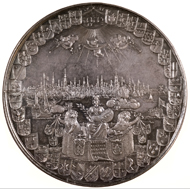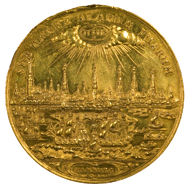May 24, 2012 – The Barber Institute of Fine Arts, Birmingham (UK), shows an exhibition on panoramic views on European coins and medals. ‘Cityscapes’ will be on display until 6 October 2013 and in addition it will be accompanied by an online exhibition.
London, Amsterdam, Hamburg, Barcelona, Venice and Budapest … Explore the historical landscapes of all these cities – and more – in Cityscapes: Panoramic Views on European Coins and Medals at the Barber Institute of Fine Arts.
Gold medal of London, struck in 1633, by Nicolas Briot. Coins and Medals, the British Museum.
The third in a series of prestigious shows organised in collaboration with the British Museum, Cityscapes highlights how, between the mid 16th century to the early 19th century, many of the great cities of Europe applied the artistic tradition of the city view to their own coins and medals – the most circulated art medium. In a world dominated by dynasties and kings, these gave physical expression in silver and gold to urban pride and civic power and showcase the exquisite skill of engravers working without modern technology.
The absorbing exhibition includes 100 loans from the British Museum, as well as objects from the Barber’s own coin collection – one of the finest collections of Roman, Byzantine and medieval Islamic coins in the world. The wonderfully intricate images in Cityscapes feature churches, citadels, fortifications, harbours, civic buildings, houses and suburbs, emphasising military or commercial power, wealth, strength and above all, divine protection and favour.
The exhibition at the University of Birmingham-based Barber Institute is accompanied by a rich and diverse programme of educational activities, lectures, gallery talks, concerts and film screenings. Cityscapes is also complemented by an online exhibition.
Silver medal of Amsterdam, struck in 1655. Coins and Medals, the British Museum.
Dr Eurydice Georganteli, Coin Curator, the Barber Institute of Fine Arts and Lecturer in Numismatics, University of Birmingham said: ‘Cities are possibly the most complex artefacts created by human intervention, shaped by geography, as well as economic, political and cultural considerations. Profound changes in the function of cities over the last two centuries have led to a steady deconstruction of the urban environment and to the cultivation of cultural amnesia. As an art historian I have always been struck by the divergence between civic pride displayed on ancient, medieval and early modern coins and medals, on one hand, and the apathy or aggression expressed by modern citizens vis-à-vis the space they inhabit.
Portugalöser of Hamburg, struck in 1689. Coins and Medals, the British Museum.
‘Cityscapes and its packed program of related activities – produced in collaboration with Birmingham City University, the UK Society for the Promotion of Byzantine Studies, the Dante Alighieri Society and the University of Birmingham – aim to engage viewers with the fascinating story of European cities. It also offers us the chance to question ideas, preconceptions and stereotypes about citizenship and our own civic, local and national identity.’
Professor Ann Sumner, Director of the Barber Institute of Fine Arts commented: ‘We are delighted to be working once again with the British Museum on this fascinating project, which has been imaginatively curated by Dr Eurydice Georganteli of the Barber and Dr Barrie Cook of the British Museum. I am sure the show will be popular with a wide range of audiences.’
Dr Barrie Cook, Curator of Medieval and Early Modern Coinage, the British Museum added: ‘This exhibition is a celebration of technical mastery, with the engravers of early modern Europe creating these city-views, simultaneously both intricate and panoramic, in such a small compass as the diameter of a coin or medal. Furthermore, they created them in three dimensions – the relief on the objects, however low, offers a depth and a gleam to the city view not present in two-dimensional media.
‘I also hope visitors get a sense of an alternative history of early modern Europe. This wasn’t just a world of kings, dynasties and great powers. It was one of lively and independent cities, and this is a part of Europe’s past that is often overlooked.’
More in formation on the Barber Institute and this exhibition are available on the website of the Institute.
You can visit the online exhibition here.







